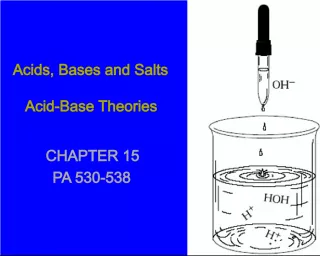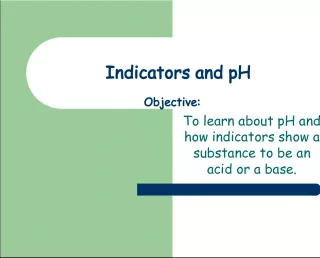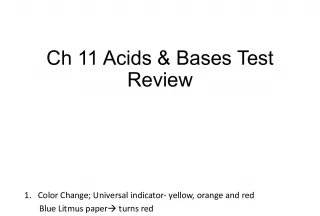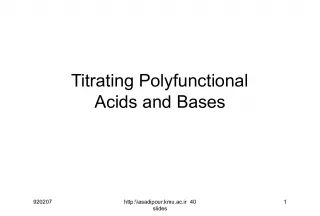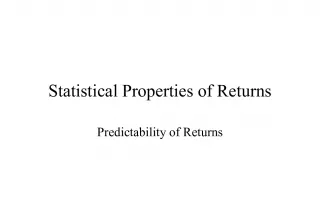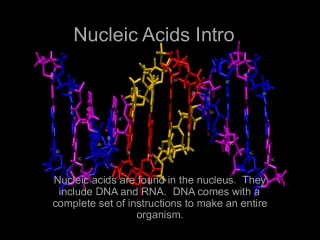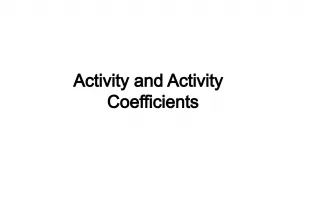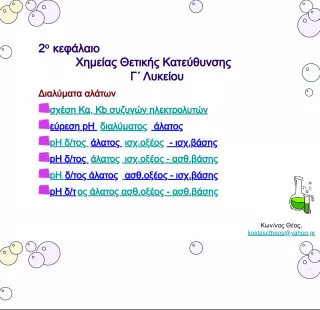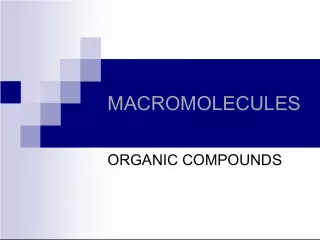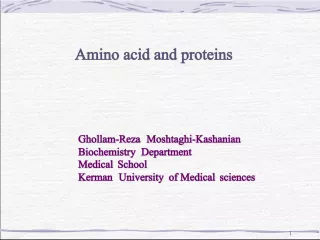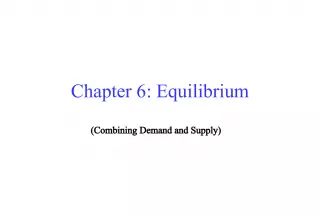Equilibrium in Solutions of Weak Acids and Weak Bases


This chapter, titled "Equilibrium in Solutions of Weak Acids and Weak Bases," is the fifteenth chapter of the 2002 Prentice Hall textbook
- Uploaded on | 1 Views
-
 jaap
jaap
About Equilibrium in Solutions of Weak Acids and Weak Bases
PowerPoint presentation about 'Equilibrium in Solutions of Weak Acids and Weak Bases'. This presentation describes the topic on This chapter, titled "Equilibrium in Solutions of Weak Acids and Weak Bases," is the fifteenth chapter of the 2002 Prentice Hall textbook. The key topics included in this slideshow are . Download this presentation absolutely free.
Presentation Transcript
Slide1Chapter FifteenPrentice-Hall © 2002 Slide 1 of 31 • 920203 • http:\\asadipour.kmu.ac.ir........57 slides • 1
Slide2Equilibrium In Solutions OfWeak Acids And Weak Bases weak acid: HA + H 2 O H 3 O + + A - [H 3 O + ][A - ] K a = [HA] weak base: B + H 2 O HB + + OH - [HB + ][OH - ] K b = [B] • 920203 • http:\\asadipour.kmu.ac.ir........57 slides • 2
Slide3Some Acid-Base Equilibrium Calculations• cHA ≈ [HA] [H 3 O + ][A - ] [H 3 O + ][A - ] K a = -------------------- = ---------------- cHA –[H 3 O + ] cHA • cHA > [HA] Analytical C > Equilibrium C • - the calculations can be simplified. • - When M acid /K a or M base /K b > 100, • - When K a or K b <1 ×10 -4 (In usual Conc.) • 920203 • http:\\asadipour.kmu.ac.ir........57 slides • 3
Slide4•920203 • http:\\asadipour.kmu.ac.ir........57 slides • 4
Slide5An Example1. Determine the concentrations of H 3 O + , CH 3 COOH and CH 3 COO - , and the pH of 1.00 M CH 3 COOH solution. K a = 1.8 x 10 -5 . 2. What is the pH of a solution that is 0.200 M in methylamine, CH 3 NH 2 ? K b = 4.2 x 10 -4 . • 920203 • http:\\asadipour.kmu.ac.ir........57 slides • 5
Slide6Are Salts Neutral, Acidic or Basic?Salts are ionic compounds formed in the reaction between an acid and a base. 1. NaCl Na + is from NaOH , a strong base Cl - is from HCl, a strong acid H 2 O NaCl (s) → Na + (aq) + Cl - (aq) Na + and Cl - ions do not react with water. The solution is neutral . • 920203 • http:\\asadipour.kmu.ac.ir........57 slides • 6
Slide7Are Salts Neutral, Acidic or Basic? 2. KCN K + is from KOH , a strong base CN - is from HCN, a weak acid H 2 O KCN (s) → K + (aq) + CN - (aq) K + ions do not react with water, but CN - ions do. CN - + H 2 O HCN + OH - hydrolysis The OH - ions are produced, so the solution is basic . • 920203 • http:\\asadipour.kmu.ac.ir........57 slides • 7
Slide8Are Salts Neutral, Acidic or Basic?3. NH 4 Cl NH 4 + is from NH 3 , a weak base Cl - is from HCl, a strong acid H 2 O NH 4 Cl (s) → NH 4 + (aq) + Cl - (aq) Cl - ions do not react with water, but NH 4 + ions do. NH 4 + + H 2 O H 3 O + + NH 3 hydrolysis The H 3 O + ions are produced, so the solution is acdic . • 920203 • http:\\asadipour.kmu.ac.ir........57 slides • 8
Slide9Are Salts Neutral, Acidic or Basic?3. NH 4 CN NH 4 + is from NH 3 , a weak base CN - is from HCN, a weak acid H 2 O NH 4 CN (s) → NH 4 + (aq) + CN - (aq) NH 4 + + H 2 O H 3 O + + NH 3 K a hydrolysis CN - + H 2 O HCN + OH - K b hydrolysis (K a > K b ,Acidic) ’’’ (K a < K b ,Basic) ‘’’ (K a = K b ,Nutral) • 920203 • http:\\asadipour.kmu.ac.ir........57 slides • 9
Slide10Ions As Acids And BasesCertain and anion ions can cause an aqueous solution to become acidic or basic due to hydrolysis. • Salts of strong acids and strong bases form neutral solutions. • Salts of weak acids and strong bases form basic solutions. • Salts of strong acids and weak bases form acidic solutions. • Salts of weak acids and weak bases form solutions that are acidic in some cases, neutral or basic in others. • 920203 • http:\\asadipour.kmu.ac.ir........57 slides • 10
Slide11Strong Acids And Strong BasesStrong acids: HCl, HBr, HI, HNO 3 , H 2 SO 4 , HClO 4 Strong bases: Group IA and IIA hydroxides • 920203 • http:\\asadipour.kmu.ac.ir........57 slides • 11
Slide12An ExampleIndicate whether the solutions (a) Na 2 S and (b) KClO 4 are acidic, basic or neutral. • 920203 • http:\\asadipour.kmu.ac.ir........57 slides • 12
Slide13The pH Of a Salt SolutionWhat is the pH of 0.1M NaCN solution? What is the pH of 0.1M NH 4 Cl solution? What is the pH of 0.1M NH 4 CN solution? K a of HCN=1.0 ×10 -9 . K b for NH3=1.0 ×10 -5 K a x K b = K w so, K b = K w /K a • 920203 • http:\\asadipour.kmu.ac.ir........57 slides • 13
Slide14Chapter FifteenPrentice-Hall © 2002 Slide 14 of 31 • 920203 • http:\\asadipour.kmu.ac.ir........57 slides • 14
Slide15Common Ion Effect Illustrated(( 1.00 M CH 3 COOH )) (( 1.00 M CH 3 COOH + 1.00 M CH 3 COONa )) yellow: pH < 3.0 blue-violet: pH > 4.6 • 920203 • http:\\asadipour.kmu.ac.ir........57 slides • 15 • CH 3 COOH CH 3 COO - + H +
Slide16The Common Ion EffectCalculate the pH of 0.10 M CH 3 COOH solution. K a of CH 3 COOH=1.0 ×10 -5 Calculate the pH of 0.10 M CH 3 COONa solution. Calculate the pH of 0.10 M CH 3 COOH/ 0.10 M CH 3 COONa solution. • 920203 • http:\\asadipour.kmu.ac.ir........57 slides • 16
Slide17Depicting Buffer Action• 920203 • http:\\asadipour.kmu.ac.ir........57 slides • 17
Slide18Buffer Solutions• A buffer solution is a solution that changes pH only slightly when small amounts of a strong acid or a strong base are added. • A buffer contains CH 3 COOH CH 3 COO - Acidic buffer NH 3 NH 4 + Alkalin buffer • 920203 • http:\\asadipour.kmu.ac.ir........57 slides • 18
Slide19How A Buffer Solution Works• The acid component of the buffer can neutralize small added amounts of OH - , and the basic component can neutralize small added amounts of H 3 O + . • CH 3 COOH CH 3 COO - + H + • 920203 • http:\\asadipour.kmu.ac.ir........57 slides • 19
Slide20Chapter FifteenPrentice-Hall © 2002 Slide 20 of 31 • Ionization constant of an acid • Taking log of the equation on both sides, • 920203 • http:\\asadipour.kmu.ac.ir........57 slides • 20
Slide21Chapter FifteenPrentice-Hall © 2002 Slide 21 of 31 • Ionization constant of an acid • Multiplying both sides of the equation by -1 • 920203 • http:\\asadipour.kmu.ac.ir........57 slides • 21 • Henderson-Hasselbach equation
Slide22Henderson-Hasselbalch EquationFor Buff Solutions [conjugate base] pH = pK a + log [conjugate acid] If [conjugate acid] = [conjugate base], pH = pK a Requirement: - [B] / [A] between 0.10 and 10 • 920203 • http:\\asadipour.kmu.ac.ir........57 slides • 22
Slide23Buffer Capacity• There is a limit to the capacity of a buffer solution to neutralize added acid or base , and this limit is reached before all of one of the buffer components has been consumed. • In general, the more concentrated the buffer components in a solution, the more added acid or base the solution can neutralize. • As a rule, a buffer is most effective if the concentrations of the buffer acid and its conjugate base are equal . [B]=[A] • [Buffer]=[Acid]+[Base] • 920203 • http:\\asadipour.kmu.ac.ir........57 slides • 23
Slide24Buffer Capacity• [Buffer]=[Acid]+[Base] • [Acid] ↑ & [Base] ↑ Capacity ↑ • In equimolar buffersis is important • Capacity ↑ • 920203 • http:\\asadipour.kmu.ac.ir........57 slides • 24
Slide25Calculations in Buffer Solutions1) A buffer solution is 0. 1 M NH 3 (pK b =5)and 1.0 M NH 4 Cl. (a) What is the pH of this buffer? • 920203 • http:\\asadipour.kmu.ac.ir........57 slides • 25
Slide26Calculations in Buffer Solutions1) A buffer solution is 0. 1 M NH 3 (pK b =5)and 1.0 M NH 4 Cl. (a) What is the pH of this buffer? (b) If 5 mmol NaOH is added to 0.500 L of this solution, what will be the pH? • 920203 • http:\\asadipour.kmu.ac.ir........57 slides • 26
Slide27Calculations in Buffer Solutions1) A buffer solution is 0. 1 M NH 3 (pK b =5)and 1.0 M NH 4 Cl. (a) What is the pH of this buffer? (b) If 5 mmol NaOH is added to 0.500 L of this solution, what will be the pH? (c) If 5 mmol HCl is added to 0.500 L of this solution, what will be the pH? • 920203 • http:\\asadipour.kmu.ac.ir........57 slides • 27
Slide28Calculations in Buffer Solutions1) A buffer solution is 0. 1 M NH 3 (pK b =5)and 1.0 M NH 4 Cl. (a) What is the pH of this buffer? (b) If 5 mmol NaOH is added to 0.500 L of this solution, what will be the pH? (c) If 5 mmol HCl is added to 0.500 L of this solution, what will be the pH? (d) If 5 mmol NH 4 Cl is added to 0.500 L of this solution, what will be the pH? • 920203 • http:\\asadipour.kmu.ac.ir........57 slides • 28
Slide29Chapter FifteenPrentice-Hall © 2002 Slide 29 of 31 Calculations in Buffer Solutions 2) What concentration of acetate ion in 500 ml of 0.500 M CH 3 COOH (pK a =5) produces a buffer solution with pH = 4.00? • 920203 • http:\\asadipour.kmu.ac.ir........57 slides • 29
Slide30Calculations in Buffer Solutions2) What concentration of acetate ion in500 ml of 0.500 M CH 3 COOH (pK a =5) produces a buffer solution with pH = 4.00? • 920203 • http:\\asadipour.kmu.ac.ir........57 slides • 30 • How many mg?
Slide31Acid-Base Indicators• An acid-base indicator is a weak acid having one color and the conjugate base of the acid having a different color. One of the “colors” may be colorless. HIn + H 2 O H 3 O + + In - • Acid-base indicators are often used for applications in which a precise pH reading isn’t necessary. • A common indicator used in chemistry laboratories is Phenolphetalein. • 920203 • http:\\asadipour.kmu.ac.ir........57 slides • 31
Slide32Chapter FifteenPrentice-Hall © 2002 Slide 32 of 31 • 920203 • http:\\asadipour.kmu.ac.ir........57 slides • 32
Slide33Chapter FifteenPrentice-Hall © 2002 Slide 33 of 31 • 920203 • http:\\asadipour.kmu.ac.ir........57 slides • 33
Slide34Neutralization Reactions• Neutralization is the reaction of an acid and a base. • Titration is a common technique for conducting a neutralization. • At the equivalence point in a titration, the acid and base have been brought together in exact stoichiometric proportions. • The point in the titration at which the indicator changes color is called the end point . • The indicator endpoint and the equivalence point for a neutralization reaction can be best matched by plotting a titration curve , a graph of pH versus volume of titrant. • In a typical titration, 50 mL or less of titrant that is 1 M or less is used. • 920203 • http:\\asadipour.kmu.ac.ir........57 slides • 34
Slide35Drawing titration Curve ForStrong Acid - Strong Base HCl + NaOH → NaCl +H 2 O Calculate the pH at the some points and draw the curve. 4 essential points. 1)initial point 2)equivalence point 3)before the equivalence point 4)beyond the equivalence point Ml تیترانت pH محیط 0 15 19 19.5 19.9 20 20.1 20.5 21 25 40 • 920203 • http:\\asadipour.kmu.ac.ir........57 slides • 35
Slide36Drawing titration Curve ForStrong Acid - Strong Base HCl + NaOH → NaCl +H 2 O 4 questions. 1)What are the present compounds? 2)Which of them is effective on pH? 3)How much are the concentrations? 4)What is the relationship between their Conc. And pH? • 920203 • http:\\asadipour.kmu.ac.ir........57 slides • 36
Slide37Drawing titration Curve ForStrong Acid - Strong Base HCl + NaOH → NaCl +H 2 O Calculate the pH at the following points in the titration of 20.00 mL of 0.500 M HCl with 0.500 M NaOH. (a) initial pH. (Before the addition of any NaOH) . Answer Q1. There are:HCl & H2O Answer Q2. HCl Answer Q3. [HCl] Answer Q4. pH=-log[H + ] • 920203 • http:\\asadipour.kmu.ac.ir........57 slides • 37
Slide38Drawing titration Curve ForStrong Acid - Strong Base HCl + NaOH → NaCl +H 2 O Calculate the pH at the following points in the titration of 20.00 mL of 0.500 M HCl with 0.500 M NaOH. b)equivalence point. Answer Q1. There are:NaCl & H 2 O Answer Q2. H 2 O Answer Q3. Answer Q4. pH=7 • 920203 • http:\\asadipour.kmu.ac.ir........57 slides • 38
Slide39Drawing titration Curve ForStrong Acid - Strong Base HCl + NaOH → NaCl +H 2 O Calculate the pH at the following points in the titration of 20.00 mL of 0.500 M HCl with 0.500 M NaOH. c)before the equivalence point. Answer Q1. There are:HCl,NaCl & H 2 O Answer Q2. HCl Answer Q3. Answer Q4. [H + ]=N pH=-log[H + ] • 920203 • http:\\asadipour.kmu.ac.ir........57 slides • 39
Slide40Drawing titration Curve ForStrong Acid - Strong Base HCl + NaOH → NaCl +H 2 O Calculate the pH at the following points in the titration of 20.00 mL of 0.500 M HCl with 0.500 M NaOH. d)after the equivalence point. Answer Q1. There are:NaOH,NaCl & H 2 O Answer Q2. NaOH Answer Q3. Answer Q4. [OH - ]=N pOH=-log[OH - ] pH=14-pOH • 920203 • http:\\asadipour.kmu.ac.ir........57 slides • 40
Slide41Titration Curve ForStrong Acid - Strong Base • pH is low at the beginning. • pH changes slowly until just before equivalence point. • pH changes sharply around equivalence point. • pH = 7.0 at equivalence point. • Further beyond equivalence point, pH changes slowly. • Any indicator whose color changes in pH range of 4 – 10 can be used in titration. • 920203 • http:\\asadipour.kmu.ac.ir........57 slides • 41
Slide42Chapter FifteenPrentice-Hall © 2002 Slide 42 of 31 Drawing titration Curve For weak acid- Strong Base CH 3 COOH + NaOH → CH3COO - + Na + +H 2 O Calculate the pH at the some points and draw the curve. K a =1 ×10 -5 5 essential points. 1)initial point 2)equivalence point 3)beyond the initial point 4)before the equivalence point 5)beyond the equivalence point • 920203 • http:\\asadipour.kmu.ac.ir........57 slides • 42
Slide43Chapter FifteenPrentice-Hall © 2002 Slide 43 of 31 Drawing titration Curve For weak acid- Strong Base CH 3 COOH + NaOH → CH3COO - + Na + +H 2 O 4 questions. 1)What are the present compounds? 2)Which of them is effective on pH? 3)How much are the concentrations? 4)What is the relationship between their Conc. And pH? • 920203 • http:\\asadipour.kmu.ac.ir........57 slides • 43
Slide44Chapter FifteenPrentice-Hall © 2002 Slide 44 of 31 Drawing titration Curve For weak acid- Strong Base CH 3 COOH + NaOH → CH3COO - + Na + +H 2 O Calculate the pH at the following points in the titration of 20.00 mL of 0.500 M CH 3 COOH with 0.500 M NaOH. (a) initial pH. (Before the addition of any NaOH) . Answer Q1. There are: CH 3 COOH & H 2 O Answer Q2. CH 3 OOH Answer Q3. CH 3 OOH Answer Q4. pH=-log[H + ] • 920203 • http:\\asadipour.kmu.ac.ir........57 slides • 44
Slide45Chapter FifteenPrentice-Hall © 2002 Slide 45 of 31 Drawing titration Curve For weak acid- Strong Base CH 3 COOH + NaOH → CH3COO - + Na + +H 2 O Calculate the pH at the following points in the titration of 20.00 mL of 0.500 M CH 3 COOH with 0.500 M NaOH. b)equivalence point. Answer Q1. There are: CH3COO - , Na + & H 2 O Answer Q2. CH3COO - Answer Q3. Answer Q4. pOH=-log[OH - ] K a ×K b =K w • 920203 • http:\\asadipour.kmu.ac.ir........57 slides • 45
Slide46Chapter FifteenPrentice-Hall © 2002 Slide 46 of 31 Drawing titration Curve For weak acid- Strong Base CH 3 COOH + NaOH → CH3COO - + Na + +H 2 O Calculate the pH at the following points in the titration of 20.00 mL of 0.500 M CH 3 COOH with 0.500 M NaOH. c)beyond the initial point. Answer Q1. There are: CH 3 COOH, CH3COO - ,Na + & H 2 O Answer Q2. CH 3 COOH, CH3COO - Answer Q3. Answer Q4. • 920203 • http:\\asadipour.kmu.ac.ir........57 slides • 46
Slide47Chapter FifteenPrentice-Hall © 2002 Slide 47 of 31 Drawing titration Curve For weak acid- Strong Base CH 3 COOH + NaOH → CH3COO - + Na + +H 2 O Calculate the pH at the following points in the titration of 20.00 mL of 0.500 M CH 3 COOH with 0.500 M NaOH. d)before the equivalence point. Answer Q1. There are: CH 3 COOH, CH3COO - ,Na + & H 2 O Answer Q2. CH 3 COOH, CH3COO - Answer Q3. Answer Q4. • 920203 • http:\\asadipour.kmu.ac.ir........57 slides • 47
Slide48Chapter FifteenPrentice-Hall © 2002 Slide 48 of 31 Drawing titration Curve For weak acid- Strong Base CH 3 COOH + NaOH → CH3COO - + Na + +H 2 O Calculate the pH at the following points in the titration of 20.00 mL of 0.500 M CH 3 COOH with 0.500 M NaOH. e)after the equivalence point. Answer Q1. There are:NaOH, CH3COO - , Na + & H 2 O Answer Q2. NaOH Answer Q3. Answer Q4. [OH - ]=N pOH=-log[OH - ] pH=14-pOH • 920203 • http:\\asadipour.kmu.ac.ir........57 slides • 48
Slide49Titration Curve ForWeak Acid - Strong Base • The initial pH is higher because weak acid is partially ionized. • At the half-neutralization point, pH = pKa. • pH >7 at equivalence point because the anion of the weak acid hydrolyzes. • The steep portion of titration curve around equivalence point has a smaller pH range. • The choice of indicators for the titration is more limited . • 920203 • http:\\asadipour.kmu.ac.ir........57 slides • 49
Slide50Chapter FifteenPrentice-Hall © 2002 Slide 50 of 31 • 920203 • http:\\asadipour.kmu.ac.ir........57 slides • 50
Slide51Chapter FifteenPrentice-Hall © 2002 Slide 51 of 31 Application of K a • The K a of nicotinic acid, HNic, is 1.4e-5. A solution containing 0.22 M HNic . What is its pH ? What is the degree of ionization ? • Solution : HNic H + + Nic – 0.22-x x x • x 2 K a = ———— = 1.4e-5 0.22 – x (use approximation, small indeed) • x = (0.22*1.4e-5) = 0.0018 pH = – log (0.0018) = 2.76 • Degree of ionization = 0.0018 / 0.22 = 0.0079 = 0.79% • • 920203 • http:\\asadipour.kmu.ac.ir........57 slides • 51
Slide52Chapter FifteenPrentice-Hall © 2002 Slide 52 of 31 Determine K a and percent ionization • Nicotinic acid, HNic, is a monoprotic acid. A solution containing 0.012 M HNic , has a pH of 3.39. What is its K a ? What is the percent of ionization ? • Solution : HNic H + + Nic – 0.012-x x x • x = [H + ] = 10 –3.39 = 4.1e-4 [HNic] = 0.012 – 0.00041 = 0.012 • (4.1e-4) 2 K a = ————— = 1.4e-5 0.012 • Degree of ionization = 0.00041 / 0.012 = 0.034 = 3.4% • 920203 • http:\\asadipour.kmu.ac.ir........57 slides • 52
Slide53Chapter FifteenPrentice-Hall © 2002 Slide 53 of 31 Using the quadratic formula • The K a of nicotinic acid, HNic, is 1.4e-5. A solution containing 0.00100 M HNic . What is its pH ? What is the degree of ionization ? • Solution : HNic H + + Nic – 0.001-x x x • x 2 K a = —————— = 1.4e-5 x 2 + 1.4e-5 x – 1.4e-8 = 0 0.00100 – x • –1.4e–5 + (1.4e–5) 2 + 4*1.4e-8 x = —————————————————— = 0.000111 M 2 pH = – log (0.000111) = 3.95 • Degree of ionization = 0.000111/ 0.001 = 0.111 = 11.1% • 920203 • http:\\asadipour.kmu.ac.ir........57 slides • 53
Slide54Chapter FifteenPrentice-Hall © 2002 Slide 54 of 31 Degree of or percent ionization • The degree or percent of ionization of a weak acid always decreases as its concentration increases, as shown from the table given earlier. • Concentration of acid • % ionization • 920203 • http:\\asadipour.kmu.ac.ir........57 slides • 54 • Deg.’f ioniz’n 0.220 0.8% 0.012 3.4 % 0.001 11.1 %
Slide55Chapter FifteenPrentice-Hall © 2002 Slide 55 of 31 Polyprotic acids • Polyprotic acids such as sulfuric and carbonic acids have more than one hydrogen to donate. • H 2 SO 4 → H + + HSO 4 – K a1 very large completely ionized • HSO 4 – H + + SO 4 2– K a2 = 0.012 • H 2 CO 3 H + + HCO 3 – K a1 = 4.3e-7 HCO 3 – H + + CO 3 2– K a2 = 4.8e-11 • Ascorbic acid (vitamin C) is a diprotic acid, abundant in citrus fruit. • Others: H 2 S, H 2 SO 3 , H 3 PO 4 , H 2 C 2 O 4 (oxalic acid) … • 920203 • http:\\asadipour.kmu.ac.ir........57 slides • 55
Slide56Chapter FifteenPrentice-Hall © 2002 Slide 56 of 31 Species concentrations of diprotic acids • Evaluate concentrations of species in a 0.10 M H 2 SO 4 solution. • Solution : H 2 SO 4 → H + + HSO 4 – completely ionized (0.1–0.1) 0.10 0.10 • HSO 4 – H + + SO 4 2– K a2 = 0.012 0.10–y 0.10+y y Assume y = [SO 4 2– ] • (0.10+y) y ————— = 0.012 (0.10-y) • [SO 4 2– ] = y = 0.01M [H+] = 0.10 + 0.01 = 0.11 M; [HSO 4 – ] = 0.10-0.01 = 0.09 M • 920203 • http:\\asadipour.kmu.ac.ir........57 slides • 56
Slide57Chapter FifteenPrentice-Hall © 2002 Slide 57 of 31 Species concentrations of weak diprotic acids • Evaluate concentrations of species in a 0.10 M H 2 S solution. • Solution : H 2 S = H + + HS – K a1 = 1.02e-7 (0.10–x) x+y x-y Assume x = [HS – ] • HS – = H + + S 2– K a2 = 1.0e-13 x–y x+y y Assume y = [S 2– ] • (x+y) (x-y) (x+y) y ————— = 1.02e-7 ———— = 1.0e-13 (0.10-x) (x-y) • [H 2 S] = 0.10 – x = 0.10 M [HS – ] = [H + ] = x y = 1.0e–4 M; [S 2– ] = y = 1.0e-13 M • 0.1>> x >> y: x+ y = x-y = x x = 0.1*1.02e-7 = 1.00e-4 y = 1e-13 • 920203 • http:\\asadipour.kmu.ac.ir........57 slides • 57
